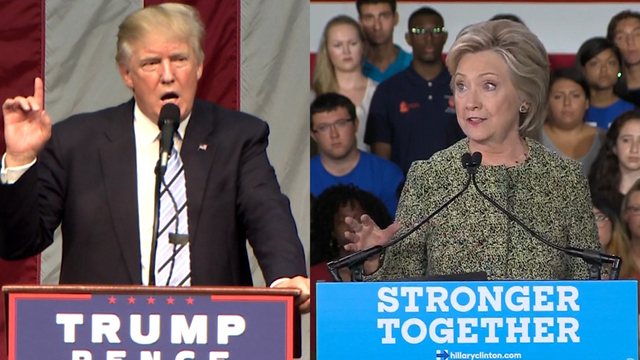How to Play the Debate: A Personal-Finance Guide

published Sep 26th 2016, 6:17 am, by Suzanne Woolley
(Bloomberg) —
Listen closely tonight. It’s your money and your life.
At 9 p.m. ET, in the first presidential debate of the season, Hillary Clinton and Donald Trump will be pressed, to a degree, for details of their various proposals. Jobs, wages, taxes, student debt, child care, Social Security … any or all of these could come up. And many of the vows, threats, visions, and hallucinations flying around the studio will eventually settle in the dustbin of history.
But some of these things will actually happen, in one form or another, so it’s a good idea to watch the proceedings with an eye, and ear, to your personal finances. Where do the candidates stick to their stated policies, and where do they diverge, or contradict themselves on issues that could affect you financially? What are they saying, and signaling? And what can you do about it?
Here, then, is your personal-finance cheat sheet for the debate. At the very least, you’ll come away from the back-and-forth with a clearer sense of its potential impact on you, your working life, and your retirement.
Where to Invest $10,000 Right Now The Seven Habits of Highly Effective Investors Jobs and wages
Clinton
The Democratic candidate vows to narrow the income gap. Her campaign promises “the largest investment in good-paying jobs since World War II,” including a $275 billion plan to rebuild U.S. infrastructure, the creation of jobs in alternative energy, and support for small manufacturers and startups. Clinton would pursue “smarter, fairer, tougher trade policies that put U.S. job creation first,” work with organized labor, gradually raise the minimum wage from $7.25 to $12 an hour, and support efforts by cities and states to raise that minimum further, citing the “Fight for $15.”
Trump
Trump also talks of raising the standard of living and says his policies will make America “the best place in the world to get a job” but stresses getting out of the way of economic growth. That means rolling back regulations on energy and other industries, reworking trade agreements that “create a smaller economy for everyone,” overhauling the tax code, and raising barriers to immigration. Trump wants to spend more than $500 billion on infrastructure. He has said the minimum wage should be up to the states but has also talked about a $10-an-hour federal floor.
You and your money
Raising the minimum wage could cost us jobs, some argue. The Congressional Budget Office, in a 2014 analysis, noted that “business owners would see reductions in real (inflation-adjusted) income, as would consumers, who would face higher prices as a result of the minimum-wage increase.” The article “Minimum Wage Mythbusters,” on the U.S. Department of Labor’s website, says raising the minimum has “little to no effect on employment as shown in independent studies from economists across the country,” citing research showing that “higher wages sharply reduce turnover which can reduce employment and training costs.” Moody’s Analytics concluded in a macroeconomic analysis (pdf) of Clinton’s economic proposals that the “negative employment affect” of a higher minimum wage would be modest, since the floor would be phased in over five years.
Whether or not you are directly affected by the minimum wage, its role in the economy and the candidates’ broader prescriptions for wage and job growth have implications for your working life and your retirement.
What you can do
Guard against lifestyle inflation that can easily creep into your spending. Tamping it down early on, to add to your savings, can pay off handsomely in the long term, since most big raises come earlier in your career. Gains slow in your 40s and 50s, and in your 50s income growth, adjusted for inflation, generally turns negative, according to financial planner Michael Kitces. With less earning power ahead of you and your options to deal with savings shortfalls narrowing, you may have to make painful spending cuts or reduce your expectations for retirement.
So if economic growth picks up, and with it your pay, try to keep your spending the same. Kitces suggests setting a lifestyle spending target—how much you want to be able to spend per year in retirement—rather than framing it as saving 10 percent or 20 percent of current income. Because he aims to save the equivalent of his annual spending times 30, he looks at everything he thinks about buying as costing 30 times as much as it does.
Social Security
Clinton
Clinton would seek to modestly expand Social Security, increasing benefits for widows and giving credits to workers who take a job leave to care for family members. To raise funds for the program, she would increase the level of annual wages subject to payroll taxes; in 2016, wages aren’t taxed after $118,500. According to a 2014 analysis (pdf) by the Center for Economic & Policy Research, the wealthiest 6.1 percent of workers would pay more if the cap were removed.
Clinton opposes reducing cost-of-living adjustments to Social Security benefits, attempts at privatization, an increase in the retirement age, and any attempts “to close the long-term shortfall on the backs of the middle class.” She has vowed to oppose any Republican plans “to privatize or ‘phase out’ Medicare as we know it” and has said she would work to drive down drug prescription costs.
Trump
Trump tweeted in May of last year that he was “the first & only potential GOP candidate to state there will be no cuts to Social Security, Medicare & Medicaid.” Growth from implementation of his economic policies would “shore up our entitlement plans for the time being,” he has said. Yet he has also noted that “as our demography changes, a prudent administration would begin to examine what changes might be necessary for future generations.”
You and your money
With defined-benefit pension plans fast receding and many workers without defined-contribution plans such as 401(k)s, Social Security income is more important than ever for more people—even as it isn’t nearly enough for most of us to realize our retirement plans. Clinton’s plan for payroll taxes would mean a pay cut for anyone making over $118,500; right now, anyone making $237,000 a year, or twice the cap, stopped paying payroll taxes on earnings on July 1.
But if changes aren’t made to shore up the program’s finances before 2034, automatic reductions in benefits will kick in, with claimants getting just 75 percent or so of their scheduled benefits.
What you can do
Regardless of how the Social Security program evolves, many people aren’t clear on how to get the biggest benefit out of it. That’s why “Get What’s Yours,” a guide to maxing out Social Security benefits by the economist Laurence Kotlikoff, became a bestseller. One of his co-authors, Philip Moeller, has the same sort of book coming out in early October, on getting the most out of Medicare.
Studying the rules can ensure a more comfortable retirement. For example, if you were born after 1943 and wait to claim benefits after the full retirement age (67 for anyone born in 1960 or later), benefits rise 8 percent a year until age 70. Try finding a safe 8 percent return anywhere else. One of the smartest moves to prepare for the cost of retirement, even if you can’t save much now, is something many younger savers are already doing—simply staying fit and healthy. Unexpected health-care costs can derail the best-laid retirement plans. (And, though it’s just a correlation, men who worked out three or more times a week made about 6 percent more than men who didn’t, according to a 2011 study from Cleveland State University. The gap was about 10 percent for women.)
Taxes
Clinton
Clinton isn’t fiddling with the marginal tax brackets but would raise taxes on high earners in a variety of ways. Her plans include a minimum rate of 30 percent for anyone with income of more than $1 million, a 4 percent surcharge on gross adjusted income over $5 million, a $1 million limit on the lifetime gift exemption, and a new tax schedule on capital gains rates. A cap on the amount of savings from itemized tax deductions would limit them to 28 percent of the value of the deduction. So those in higher tax brackets wouldn’t get a greater benefit from, say, taking the mortgage interest deduction, the Tax Foundation notes.
Clinton would lower the starting point at which estates are taxed to $3.5 million ($7 million for married couples) and raise the top estate tax rate to 45 percent from 40 percent. She’d also seek to limit the ability to pass on appreciated assets to heirs free of capital-gains taxes before death, though she’d protect “small and closely held businesses, farms and homes, and personal property and family heirlooms.”
Trump
Trump’s tax plan would cut the number of income-tax brackets from seven to three—12 percent on income up to $75,000, 25 percent for $75,000 to $225,000, and 33 percent on income over that. That means top earners would no longer face a 39.6 percent tax bracket.
The standard deduction for single filers would be $15,000, and $30,000 for joint filers. Itemized deductions would be capped at $100,000 for single filers and $200,000 for married couples filing jointly. Trump would kill the estate tax and keep the popular mortgage interest deduction.
You and your money
Clinton’s approach would cost wealthy families the most, while they would appear to benefit under Trump. Whatever happens in the end, the debate over taxes is a good reminder to pay attention to the tax treatment of your investments. Vigilance can boost your income in what could be a low-return environment if the economy continues on its current path.
What you can do
Start thinking about yearend moves to lessen the pain next April. For the longer term, calculate what your total annual income from Social Security and other sources would be in retirement, and what the federal and state taxes on that income could be . The first of the baby boomers just hit 70 and a half, when they have to start taking required minimum distributions from IRAs. These annual withdrawals can push people into a higher tax bracket.
Financial planners suggest strategies using a variety of retirement accounts to try to minimize the tax bite. To use that strategy effectively, you have to explore it well ahead of time. By shifting money between traditional IRAs and Roth IRAs and other accounts, and paying tax on some accounts at opportune times, you can lessen the tax bite and add years of retirement income.
Child-care costs
Clinton
Clinton would cap the cost of a family’s child care at 10 percent of household income using tax credits and subsidized child care. She has talked about a national system for paid family leave of up to 12 weeks as well as universal preschool for four-year-olds.
Child-care workers would be paid better. (“In many places, dog trainers are paid more than child-care workers,” she has said.) Child care is part of Clinton’s “New College Compact,” which proposes significant improvements for child care on campus and up to $1,500 a year in scholarships to college students who are parents.
Trump
Trump has promised a mandatory six-week paid family leave and would let parents deduct the costs of raising a child up to age 13, for up to four kids. To help lower-income taxpayers who may not pay income tax, the Earned Income Tax Credit would be raised to “half of the payroll taxes paid by the lower-earning parent,” with an income limit of $31,200 for single taxpayers and $62,400 for joint filers.
Trump’s plan would let parents create dependent-care savings accounts. Contributions would max out at $2,000 a year, and earnings would accumulate tax-deferred. Balances could be rolled over and used for higher education when a child turns 18. The annual cap on the business tax credit for child care that employers offer on site would rise from $150,000 to $500,000.
You and your money
The cost of child care tops college tuition in many states, according to a 2015 report from the Economic Policy Institute (EPI), a liberal think tank, as well as monthly rent. Corporate day-care centers would be ideal for many parents but are far and few between, so any relief would be a big help.
Some employees already have access to dependent care flexible savings accounts (FSAs). The Tax Policy Center has said Trump’s proposal “would mostly benefit high-income families who need government child care subsidies the least” and that “for those who need it the most, such as low-income married couples with a single earner, there is much less to Trump’s plan than meets the eye.”
What you can do
This is a tough one. If you want to gather support among other working parents at your company and raise the prospect of on-site day care, you can show your employer this article about the positive experience that such companies as Patagonia and Goldman Sachs have had with such arrangements. Creative solutions are cropping up for some parents, such as the Workaround, in Brooklyn, N.Y., a co-working space where people earn credits for watching one another’s kids, which they can use when they need child care.
If your company offers a dependent care FSA, try to fund it fully. It lets you pay for child care out of pretax pay, which makes it stretch further while lowering your taxable income. In 2016, the limit on what you could contribute tax-deferred was $5,000 for a married couple filing a joint return. Also, take advantage of any discounted group legal services offered through your benefit plan to make a will, if you haven’t already, and of any elder care programs offered.
And with that, enjoy the debate.
To contact the author of this story: Suzanne Woolley in New York at swoolley2@bloomberg.net To contact the editor responsible for this story: Peter Jeffrey at pjeffrey@bloomberg.net
COPYRIGHT
© 2016 Bloomberg L.P
NICODES







No Comment